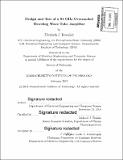Design and test of a 94 GHz overmoded traveling wave tube amplifier
Author(s)
Kowalski, Elizabeth J. (Elizabeth Joan)
DownloadFull printable version (26.99Mb)
Other Contributors
Massachusetts Institute of Technology. Department of Electrical Engineering and Computer Science.
Advisor
Richard J. Temkin.
Terms of use
Metadata
Show full item recordAbstract
This thesis discusses the design and test of an overmoded W-band Traveling Wave Tube (TWT). The TWT was designed to operate in the rectangular TM31 cavity mode at 94 GHz. The unwanted lower order, TM₁₁ and TM₂₁, modes were suppressed using selectively placed aluminum nitride dielectric loading. Simulations in 3-D CST Particle Studio confirmed suppression of unwanted modes due to dielectric loading and operation in the TM31 mode. The TWT was designed to operate at 31 kV with 310 mA and a 2.5 kG solenoid magnet. Simulations in both 1-D Latte and 3-D CST predicted 32 dB of gain, 200 MHz bandwidth, and 300 W peak output power for the TWT at 94 GHz. Test structures of 9- and 19- cavities were made via CNC direct machining. Cold test measurements showed suppression of the unwanted modes and transmission of the TM₃₁ mode, which correlated well with HFSS simulations. Two final 87-cavity structures were built and cold tested. The experiment was designed and built in-house at MIT (with exception of the electron gun cathode, manufactured by industry). It was operated with a 3 microsecond pulsed power supply. A beam test was implemented which confirmed operation of the TWT set up and electron gun. The electron gun operated at 31 kV with 306+/-6 mA of current detected at the collector and 88 % transmission of current. Initial operation of the TWT showed zero-drive stable operation and demonstrated 8 dB of device gain and 10 W peak output power at 95.5 GHz. Following these first tests, the magnetic field alignment was improved and the second structure, which showed better circuit transmission in cold test, was installed. The overmoded TWT produced 21 2 dB device gain (defined as Pout/Pin) at 94.3 GHz and 27 W of saturated output power in zero-drive stable operation. The TWT was estimated to have about 6 dB of additional loss due to coupling into and out of the circuit. Taking that loss into account, the gain on the TWT circuit itself was estimated to be 27*/- 2 dB circuit gain. CST simulations for the experimental current and voltage predict 28 dB circuit gain, in good agreement with measurements. This experiment demonstrated the first successful operation of an overmoded TWT. The overmoded TWT is a promising approach to high power TWT operation at W-Band and to the extension of the TWT to terahertz frequencies.
Description
Thesis: Ph. D., Massachusetts Institute of Technology, Department of Electrical Engineering and Computer Science, 2015. Cataloged from PDF version of thesis. Includes bibliographical references (pages 175-180).
Date issued
2015Department
Massachusetts Institute of Technology. Department of Electrical Engineering and Computer SciencePublisher
Massachusetts Institute of Technology
Keywords
Electrical Engineering and Computer Science.